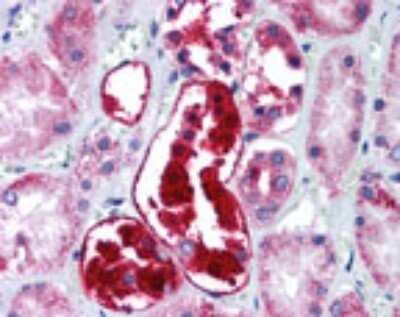ATG5 Antibody - BSA Free
Novus Biologicals, part of Bio-Techne | Catalog # NBP2-24389


Conjugate
Catalog #
Key Product Details
Species Reactivity
Validated:
Human, Mouse, Rat, Porcine, Bovine
Cited:
Human, Mouse, Porcine
Predicted:
Chicken (95%). Backed by our 100% Guarantee.
Applications
Validated:
Immunohistochemistry, Immunohistochemistry-Paraffin, Western Blot
Cited:
WB
Label
Unconjugated
Antibody Source
Polyclonal Rabbit IgG
Format
BSA Free
Concentration
1.0 mg/ml
Product Specifications
Immunogen
This ATG5 antibody is made against a portion of amino acid 1-50 of human APG5L.
Reactivity Notes
Immunogen displays the following percentage of sequence identity for non-tested species: 100% homologous in Opossum, Equine, Canine, Monkey, Chimpanzee; Xenopus (80%).
Clonality
Polyclonal
Host
Rabbit
Isotype
IgG
Scientific Data Images for ATG5 Antibody - BSA Free
Western Blot: ATG5 Antibody [NBP2-24389] - Western blot analysis of human APGL5 in T98G cell lysate in 1) absence, 2) presence of immunizing peptide using this antibody at 1 ug/mL.
Immunohistochemistry-Paraffin: ATG5 Antibody [NBP2-24389] - Immunohistochemistry analysis of human kidney using this antibody at 5 ug/mL.
Applications for ATG5 Antibody - BSA Free
Application
Recommended Usage
Immunohistochemistry
5 ug/mL
Immunohistochemistry-Paraffin
5 ug/mL
Western Blot
0.5 - 2 ug/mL
Application Notes
The optimal dilution should be determined by the end user.
Formulation, Preparation, and Storage
Purification
Immunogen affinity purified
Formulation
PBS
Format
BSA Free
Preservative
0.02% Sodium Azide
Concentration
1.0 mg/ml
Shipping
The product is shipped with polar packs. Upon receipt, store it immediately at the temperature recommended below.
Stability & Storage
Store at 4C short term. Aliquot and store at -20C long term. Avoid freeze-thaw cycles.
Background: ATG5
In the context of its role in autophagy, Atg5 plays diverse physiologically relevant roles. For example, Atg5 together with Atg7 are required for adipogenesis (3). Recently, Atg5 has been implicated in the process of B-cell receptor polarization and antigen presentation (4). In addition to its role in autophagy, Atg5 is implicated in apoptotic cell death. Interaction of Atg5 with FADD (Fas-associated protein with death domain) is involved in cell death induced by IFN-gamma. A truncated form of Atg5, a 24kDa fragment, leads to cell death by interacting with Bcl-xl and inhibiting its anti-apoptotic activity (5). Other Atg5 interacting partners include interleukin-beta (IL-beta) converting enzyme and nucleotide binding oligomerization domain protein 1, which suggest that Atg5 may play other biologically relevant roles (3).
References
1. Yang, Z., & Klionsky, D. J. (2010). Mammalian autophagy: Core molecular machinery and signaling regulation. Current Opinion in Cell Biology. https://doi.org/10.1016/j.ceb.2009.11.014
2. Rubinsztein, D. C., Shpilka, T., & Elazar, Z. (2012). Mechanisms of autophagosome biogenesis. Current Biology. https://doi.org/10.1016/j.cub.2011.11.034
3. Subramani, S., & Malhotra, V. (2013). Non-autophagic roles of autophagy-related proteins. EMBO Reports. https://doi.org/10.1038/embor.2012.220
4. Arbogast, F., Arnold, J., Hammann, P., Kuhn, L., Chicher, J., Murera, D., Gros, F. (2019). ATG5 is required for B cell polarization and presentation of particulate antigens. Autophagy. https://doi.org/10.1080/15548627.2018.1516327
5. Luo, S., & Rubinsztein, D. C. (2007). Atg5 and Bcl-2 provide novel insights into the interplay between apoptosis and autophagy. Cell Death and Differentiation. https://doi.org/10.1038/sj.cdd.4402149
Long Name
ATG5 Autophagy Related 5 Homolog
Alternate Names
APG5, ASP
Gene Symbol
ATG5
Additional ATG5 Products
Product Documents for ATG5 Antibody - BSA Free
Product Specific Notices for ATG5 Antibody - BSA Free
This product is for research use only and is not approved for use in humans or in clinical diagnosis. Primary Antibodies are guaranteed for 1 year from date of receipt.
